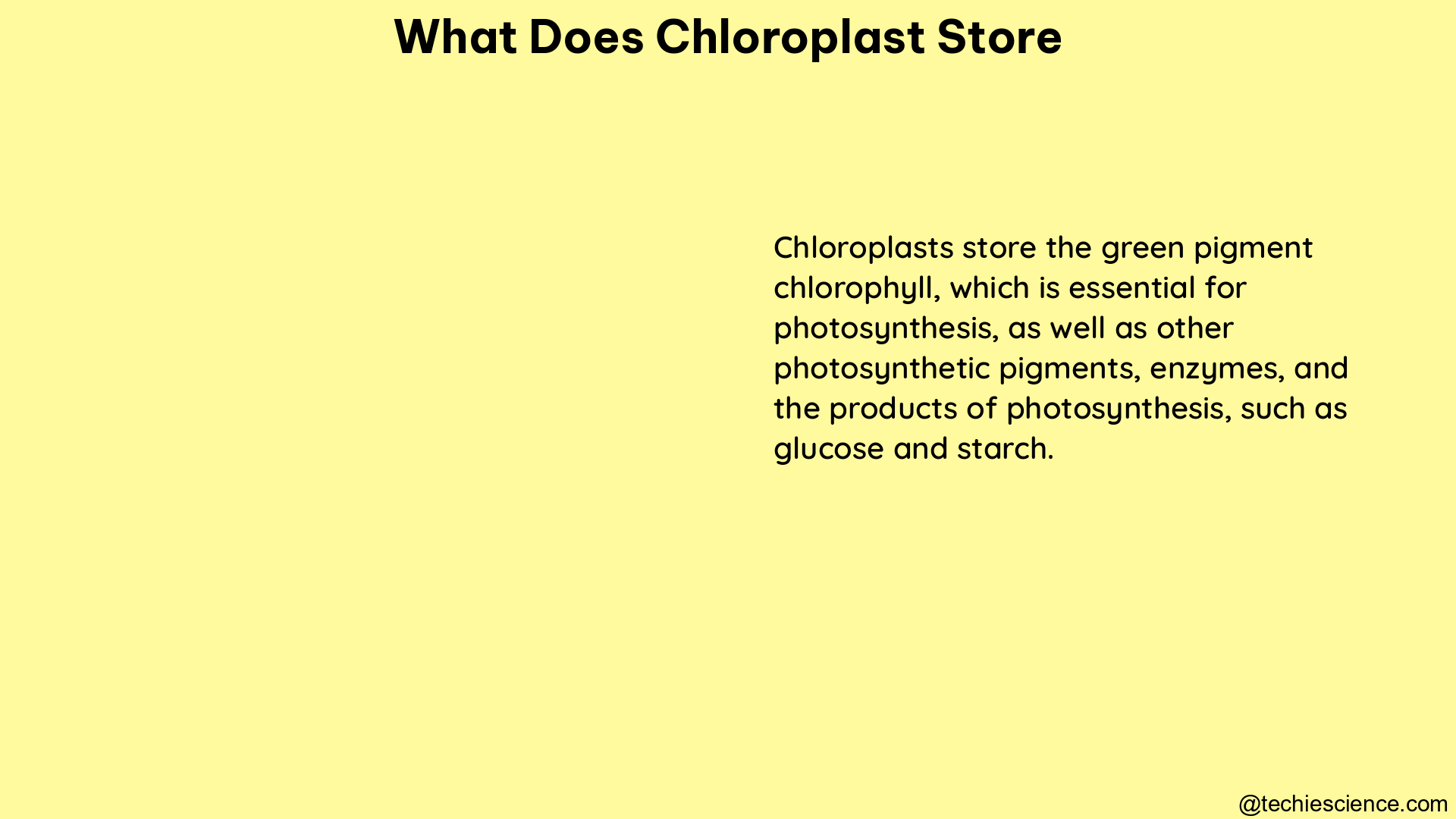Chloroplasts are essential organelles in plant cells that store and utilize various compounds to carry out photosynthesis, a process that converts light energy into chemical energy. The primary components that chloroplasts store are pigments, proteins, and lipids, which are crucial for the structural and functional organization of the thylakoid membrane system.
Chloroplast Pigments: The Light-Harvesting Powerhouses
Pigments, particularly chlorophylls, are vital for light absorption during photosynthesis. Chloroplasts store two main types of chlorophyll: chlorophyll a and chlorophyll b. These pigments are organized into complexes called photosystems, which are located on the thylakoid membranes.
- Chlorophyll a: This is the primary photosynthetic pigment, responsible for the green color of plants. Chlorophyll a absorbs light in the blue and red regions of the visible spectrum, with absorption peaks at around 430 nm and 660 nm.
- Chlorophyll b: This accessory pigment complements the light-harvesting capabilities of chlorophyll a by absorbing light in the blue-green and orange-red regions of the spectrum, with absorption peaks at around 450 nm and 640 nm.
In addition to chlorophylls, chloroplasts also store carotenoids, which are yellow, orange, and red pigments that play a crucial role in light harvesting and photoprotection. Some examples of carotenoids found in chloroplasts include:
- Carotenes: β-carotene and α-carotene
- Xanthophylls: Lutein, violaxanthin, and neoxanthin
The precise composition and concentration of these pigments can vary among different plant species, developmental stages, and environmental conditions, reflecting the adaptability of the photosynthetic apparatus.
Chloroplast Proteins: The Machinery of Photosynthesis

Proteins are another critical component that chloroplasts store. These proteins include the reaction center proteins, antenna proteins, and electron transport chain components necessary for photosynthesis. Some of the key protein complexes found in chloroplasts include:
- Photosystem I (PSI): This complex is responsible for the light-dependent reactions of photosynthesis, where it absorbs light energy and uses it to drive the transfer of electrons through the electron transport chain.
- Photosystem II (PSII): This complex is also involved in the light-dependent reactions, where it uses light energy to split water molecules, releasing electrons that are then used to power the electron transport chain.
- Cytochrome b6f Complex: This protein complex acts as an electron transport hub, shuttling electrons between the two photosystems and helping to generate a proton gradient that is used to drive the synthesis of ATP.
- ATP Synthase: This enzyme complex uses the proton gradient generated by the electron transport chain to power the synthesis of ATP, the primary energy currency of the cell.
In addition to these core photosynthetic complexes, chloroplasts also store a variety of other proteins, such as enzymes involved in carbon fixation (e.g., Rubisco), pigment biosynthesis, and other metabolic processes.
Chloroplast Lipids: The Structural Foundation
Lipids are also stored in chloroplasts, primarily as components of the thylakoid membranes. The main lipids found in chloroplasts are:
- Galactolipids: These include monogalactosyldiacylglycerol (MGDG) and digalactosyldiacylglycerol (DGDG), which are the most abundant lipids in the thylakoid membranes.
- Sulfolipids: These include sulfoquinovosyldiacylglycerol (SQDG), which helps maintain the structural integrity of the thylakoid membranes.
- Phospholipids: These include phosphatidylglycerol (PG), which is involved in the assembly and organization of the photosynthetic complexes.
These lipids provide structural support and help maintain the integrity of the thylakoid membranes, allowing for the proper functioning of the photosynthetic apparatus. The specific lipid composition and organization within the thylakoid membranes can vary depending on the plant species, developmental stage, and environmental conditions.
Quantitative Insights into Chloroplast Storage Capacity
The size and number of chloroplasts can provide insights into their storage capacity. For instance, chloroplasts in mesophyll cells of the model plant Arabidopsis thaliana have an average diameter of 448 ± 16 nm and a height of 113 ± 5 nm. Moreover, chloroplasts in bundle sheath (BS) cells are generally larger than those in mesophyll (M) cells and occupy a greater volume per cell.
The number of chloroplasts per cell can also vary depending on the plant species and cell type. In Arabidopsis, mesophyll cells can contain up to 100 chloroplasts, while bundle sheath cells may have as many as 200 chloroplasts. This variation in chloroplast size and number reflects the adaptability of the photosynthetic apparatus to different environmental conditions and metabolic demands.
Conclusion
In summary, chloroplasts store a diverse array of pigments, proteins, and lipids that are essential for the process of photosynthesis. The precise composition and organization of these components can vary among different plant species, developmental stages, and environmental conditions, reflecting the adaptability of the photosynthetic apparatus.
Understanding the storage capacity and composition of chloroplasts can provide valuable insights into plant physiology and contribute to the development of strategies for improving plant performance, such as enhancing photosynthetic efficiency or stress tolerance. By delving into the intricate details of what chloroplasts store, biology students can gain a deeper appreciation for the remarkable complexity and versatility of these essential organelles.
References:
– Chloroplast Structure and Function
– Chloroplast Lipids
– Chloroplast Division
– Chloroplast Pigments and Photosystems
– Chloroplast Protein Complexes
Hey! I am Sneha Sah, I have completed post graduation in Biotechnology. Science has always been fascinating to me and writing is my passion. As an academic writer my aim is to make Science easy and simple to learn and read.